[Editor’s note: This is the third feature story in a deeply researched series from our friends at Hakai Magazine about the paradox of manufactured fish and how salmon hatcheries have gone from cure to Band-Aid to crutch. If you haven’t yet, we encourage you to read the first feature, 'The Hatchery Crutch,' and the second feature, ‘Can We Have Too Much Pink Salmon?’]
Elizabeth Ruiz parked the white pickup at the side of a winding road, climbed out of the cab, and looked around in disbelief at what was left of the narrow valley: How could any salmon have possibly survived? Once a redwood forest so lush that the land’s contours were lost in it, every ridge and gulley was now exposed, eerily radiant under the Creamsicle-orange sky. Patches of ground still smouldered from the Walbridge Fire, which had blazed through the valley seven weeks earlier, in August 2020.
Ruiz, a biologist with the science agency California Sea Grant, adjusted their N95 mask for protection from the haze. Dark hair tucked under a hard hat and wading boots kicking up ash, Ruiz clambered carefully down the steep bank to Mill Creek. They were accompanied by a four-person field crew, all dedicated to saving a population of coho, one of the most endangered runs of salmon on the west coast of North America. Even bird calls rarely disturbed the quiet. Nearly all the wildlife had fled.
“It felt like we were at the end of the world,” Ruiz says, recalling that mild October day.
It’s not as though this corner of California had been pristine before 2020’s record-setting fire season. Mill Creek is part of the Russian River watershed, which drains 3,900 square kilometres of Sonoma and Mendocino counties. It’s an hour’s drive north of San Francisco, near enough that early buildings in the city were crafted with redwoods hauled from this watershed. So much gravel has been mined from the river — some of it used to construct the Golden Gate Bridge — that in places the streambed dropped by the height of a two-storey house. In the late 1950s and early 1980s, the US Army Corps of Engineers built dams on the Russian River to flood the Lake Mendocino and Lake Sonoma reservoirs, walling off fish habitat. Scattered throughout the watershed, 500 smaller dams also prevented coho from reaching important spawning tributaries. By 2012, vineyards and wineries had become the dominant industry in Sonoma County, part of the wider region the tourism industry calls “wine country.” The complex landscape of oak-dotted hills and steep canyons that was once a haven for locally adapted salmon and steelhead now lends local vino its distinctive terroir.
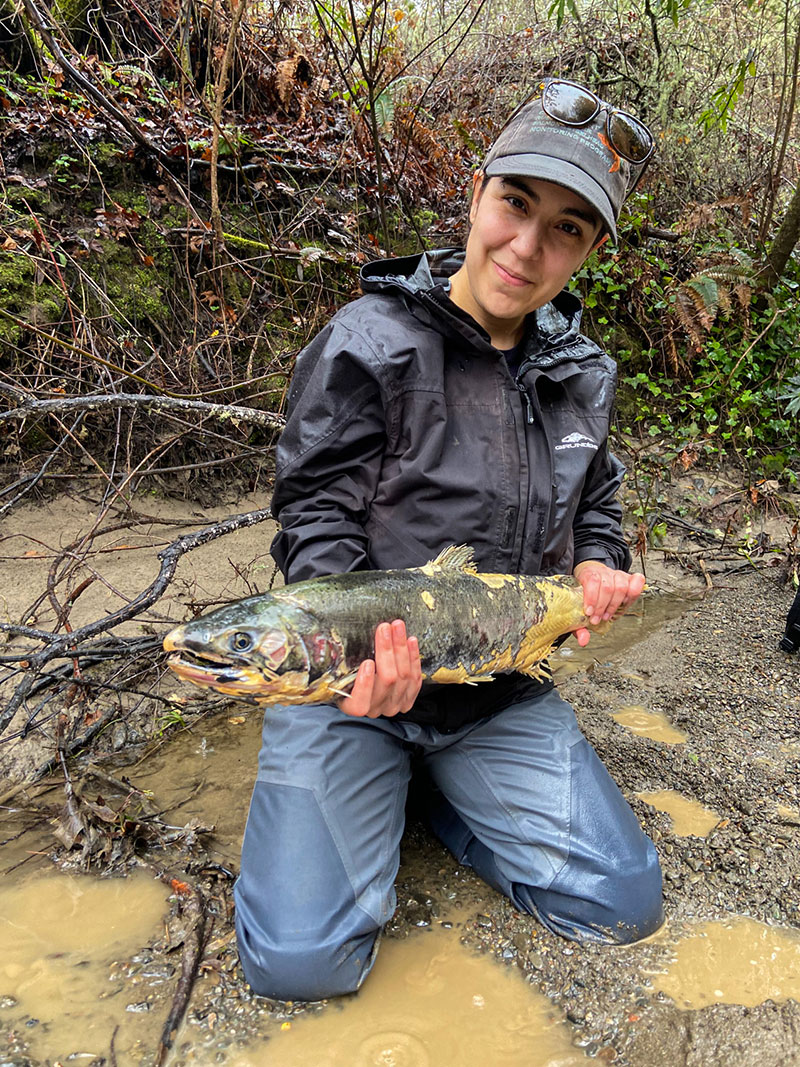
A century ago, roughly 20,000 coho — a salmon species known for spawning in even the smallest creeks — would return to the Russian River and its tributaries in a typical year. By 1988, the number had fallen by 95 per cent. In 2000, only six coho returned to spawn. Over the following three years, a coalition of county, state and federal agencies brought the watershed’s last young coho into captivity at Warm Springs Fish Hatchery, near Lake Sonoma, 30 kilometres inland from the coast. The species has vanished or is on the cusp of disappearing in all but three places in central California, the southernmost limit of coho’s wild range. In the Russian River, the intervention was a moonshot attempt to keep the population alive.
Today, 500 to 1,000 coho return to the Russian River each winter to spawn. Some were born at the Warm Springs hatchery, others in the river, spawned by hatchery-born fish. Nearly all are descended from those last wild fish that were taken into captivity between 2001 and 2003. For almost 20 years, Warm Springs has sustained a coho run in a watershed that no longer has a wholly wild population of the species.
The hatchery sits at the foot of Lake Sonoma’s imposing earthen dam, which is still black from a recent prescribed burn by the Army Corps to prevent plant roots from weakening its structure. A steep concrete channel steadily spills reservoir water into Dry Creek and supplies the hatchery. Despite its name, Dry Creek is now one of the only waterways in the drought-prone watershed that dependably flows year round. Downstream of the scorched dam, the landscape alongside the creek opens onto endless rows of grapevines.
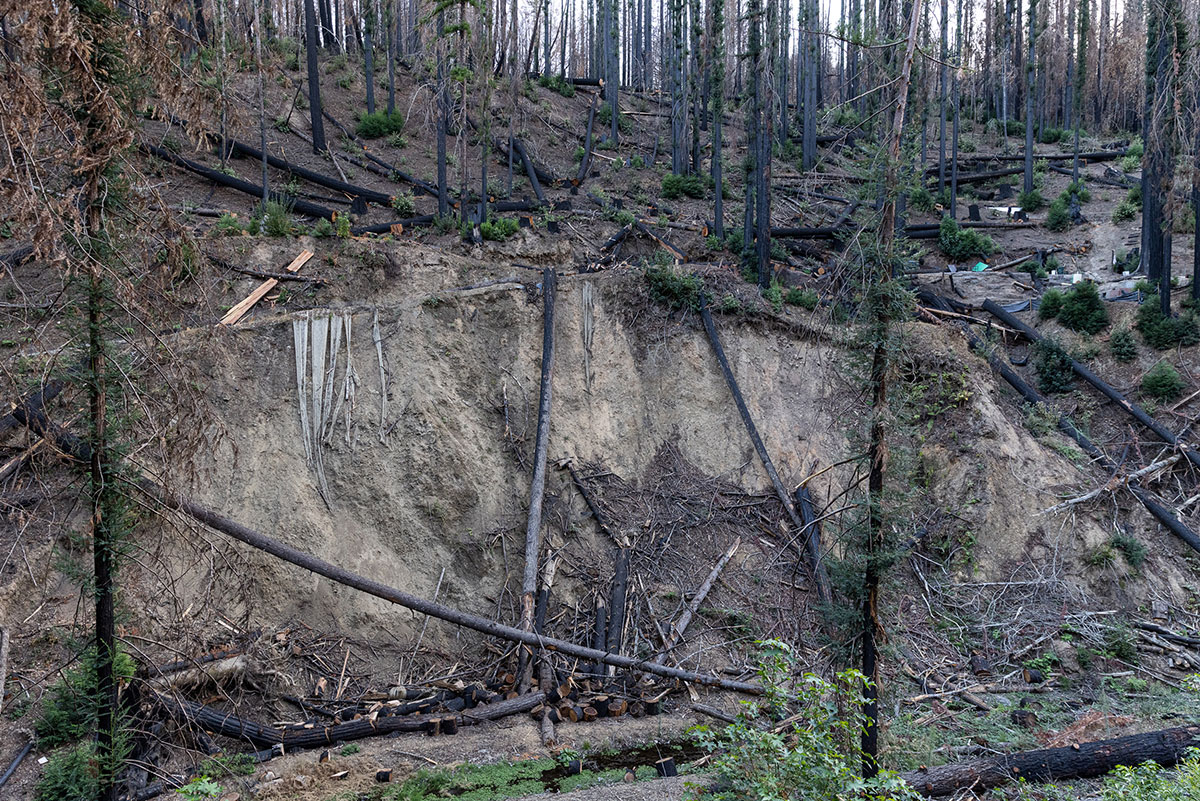
Twenty kilometres southeast of the hatchery, Mill Creek empties out of the rugged Coast Range into Dry Creek. Before the Walbridge Fire, Mill Creek was the perfect place in the watershed to study critically endangered coho. The valley cuts through the rainiest spot in Sonoma County, capturing water that the once thickly forested slopes kept cool through the summer. Each year, Warm Springs staff searched the creek for the best habitat, often stocking young salmon in the tributary’s upper reaches. But when Ruiz and their co-workers waded into the creek after the Walbridge Fire, ash drifted on the water and the gravel bars were streaked with iron-red flame retardant from the fight to save nearby homes. Shaken by the surreal scene, the team got to work searching for salmon. One person donned a heavy backpack wired to a long pole that emits an electrical charge into the water to temporarily stun fish. Ruiz and a colleague scooped the dazed animals into a bucket to be identified, tagged and carefully released. By day’s end, they had found close to two dozen coho. In the Russian River watershed, in 2020, after a devastating fire that qualified as good news.
Relieved, the crew went for ice cream. The salmon had pulled through. For now.
The Russian River represents one possible future — perhaps the most likely one — for many other rivers on the west coast of North America: they will have hatchery salmon or no salmon at all. In this heavily developed watershed, climate change is already escalating droughts, fires and floods, providing a preview of what may be in store for other regions. As wild stocks decline due to environmental change and other pressures, the hope is that facilities like Warm Springs, often described as “conservation hatcheries,” can keep salmon runs intact until their habitats are restored. It’s a task that sometimes verges on the impossible. As Mariska Obedzinski, who has led California Sea Grant’s coho monitoring program in the Russian River for almost 18 years, puts it, “It can feel like one step forward and five steps back.”
Hatcheries hold up a mirror to the stubborn belief that salmon can exist without intact habitat. On the west coast of North America, they have been used for over a century to supplement wild salmon in places where logged, dammed and developed watersheds can no longer support abundant runs. But can salmon raised in captivity really replace wild ones? It’s a question I’ve been pondering for years, and, full disclosure, I once co-authored an opinion editorial with a consortium of salmon conservationists encouraging the British Columbia government to restore fish habitat, rather than build more hatcheries.
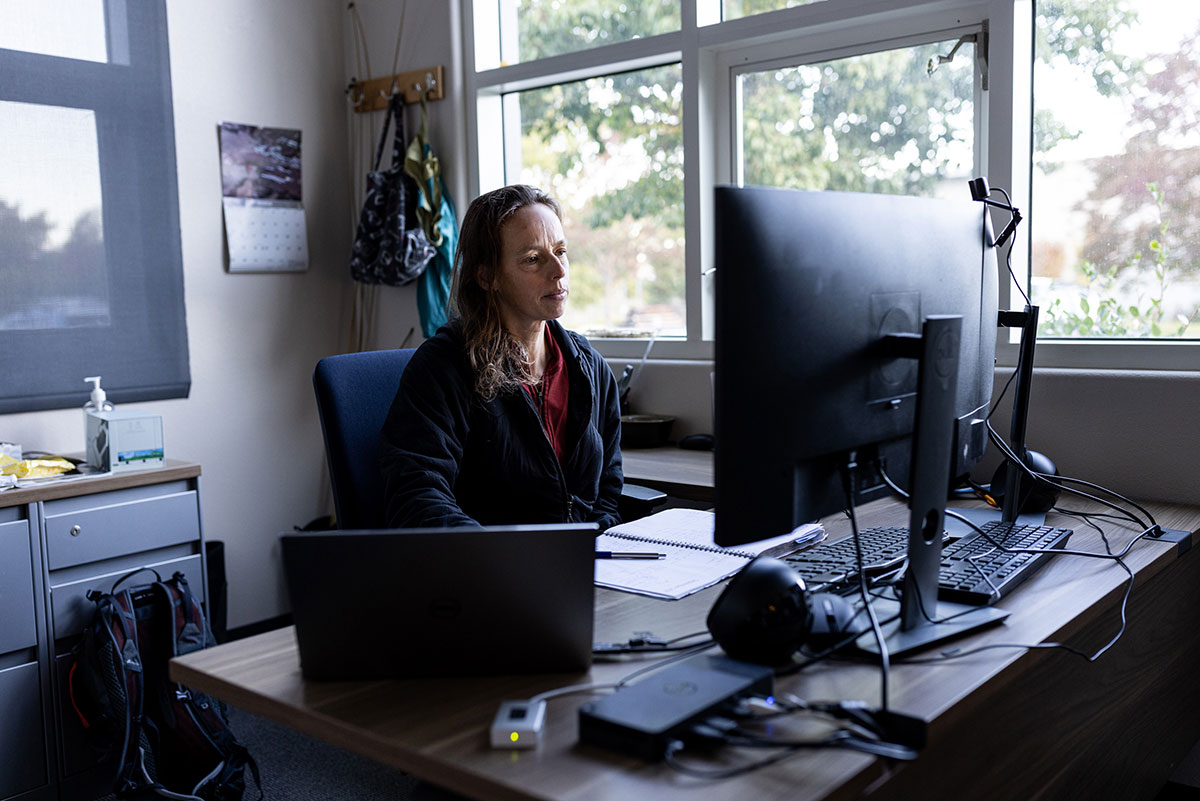
By the mid-20th century, scientists were finding evidence that artificially propagated fish were struggling to survive in the wild. “There is something wrong with hatchery trout,” a US Fish and Wildlife Service biologist wrote in 1948, suggesting that the fish — close cousins to salmon — were becoming domesticated. Today, hatchery salmon are generally bigger, bolder and more combative than wild salmon; when produced by the tens or hundreds of thousands, they can outcompete wild fish. Paradoxically, though, nearly all hatchery salmon die quickly from poor life skills — failure to avoid predators or to successfully find food — or succumb to stress in the strange new environment. One facility manager told me that his coho had consumed bits of wood after release, likely mistaking the fragments for commercial feed pellets. “Hatchery fish are animals that are dressed in the skin of the salmon, but they’re missing most of what makes a salmon a salmon,” says Jim Lichatowich, a retired fish biologist and author of Salmon Without Rivers. “They don’t have that 10,000-year study of one place.”
Wild Pacific salmon are, in contrast, diligent students of place: each population is distinct and uniquely adapted to its creek or river. New genetic tools gave ecologists the power to document this remarkable diversity in the 1950s and ’60s, but geneticists soon cautioned that hatchery fish could degrade wild gene pools, potentially contributing to declines driven by overfishing and habitat destruction. In 1991, Snake River sockeye became the first west coast salmon population listed as endangered under the U.S. Endangered Species Act. Canada’s expert committee on the status of wildlife identified the country’s first three endangered Pacific salmon stocks in 2002. Some hatchery managers proposed cultivating more fish to stem such declines, but true recovery seemed unlikely unless the facilities could produce fish as resilient as wild ones.
In 1997, Yakama Nation Fisheries, the fish management arm of the Confederated Tribes and Bands of the Yakama Nation, began collecting wild spring Chinook for a new hatchery and research facility — Cle Elum Supplementation and Research Facility — in central Washington. Historically, the Yakima Basin of the Columbia River supported 200,000 springs. (This type of Chinook migrates back to fresh water as adults in the spring, while “fall” Chinook return later in the year.) By the late 1990s, though, salmon returning from the Pacific Ocean had to navigate nine dams on the Columbia and Yakima rivers, and the stock had plummeted by more than 98 per cent. Levi George, Yakama Nation chairman and an influential leader in the fight for fishing rights, envisioned the tribes and bands producing salmon for their own harvest, explains tribal member Charlie Strom, who manages the facility, which aims to protect and restore culturally important fish populations. But the Yakama weren’t looking for a traditional hatchery fish. They wanted something closer to the wild Chinook that had been lost.
At Cle Elum, Yakama Nation Fisheries was among the first to apply conservation hatchery techniques by bringing the river into the hatchery, so to speak. They painted the concrete channels in dappled greens and tans with the hope that this would trigger the young fish to develop camouflaging colours. They also shaded the water and submerged defoliated evergreen trees to act as hiding spots. Instead of tossing fish feed into the water by hand — which teaches salmon to approach shadows on the surface that, in the wild, are likely to be cast by predators — at Cle Elum, food was dispensed underwater. For the first five years, Yakama Nation Fisheries compared these seminatural conditions for raising Chinook to traditional barren channels at the facility.
Other hatcheries were running similar experiments. In one, U.S. National Oceanic and Atmospheric Administration scientists trying to teach juvenile salmon to evade predators turned loose several fish-hunting ducks in a living room–sized tank; the only fish to survive the carnage were found wedged inside the aluminum mount for an underwater camera. Other results were more hopeful. Rob Brouwer, manager of a large hatchery on Vancouver Island, remembers visiting two of his outdoor pools one summer night in 2004. The first was devoid of enhancements, the other practically a playground, with shade, branches, jets of cooler water and fewer fish. In the evening light, the first pool was still, as usual. But the enhanced pool rippled with movement; as Brouwer watched, two coho chased each other, leaping across the surface.
“They were playing,” Brouwer says. “That’s what enrichment does.”
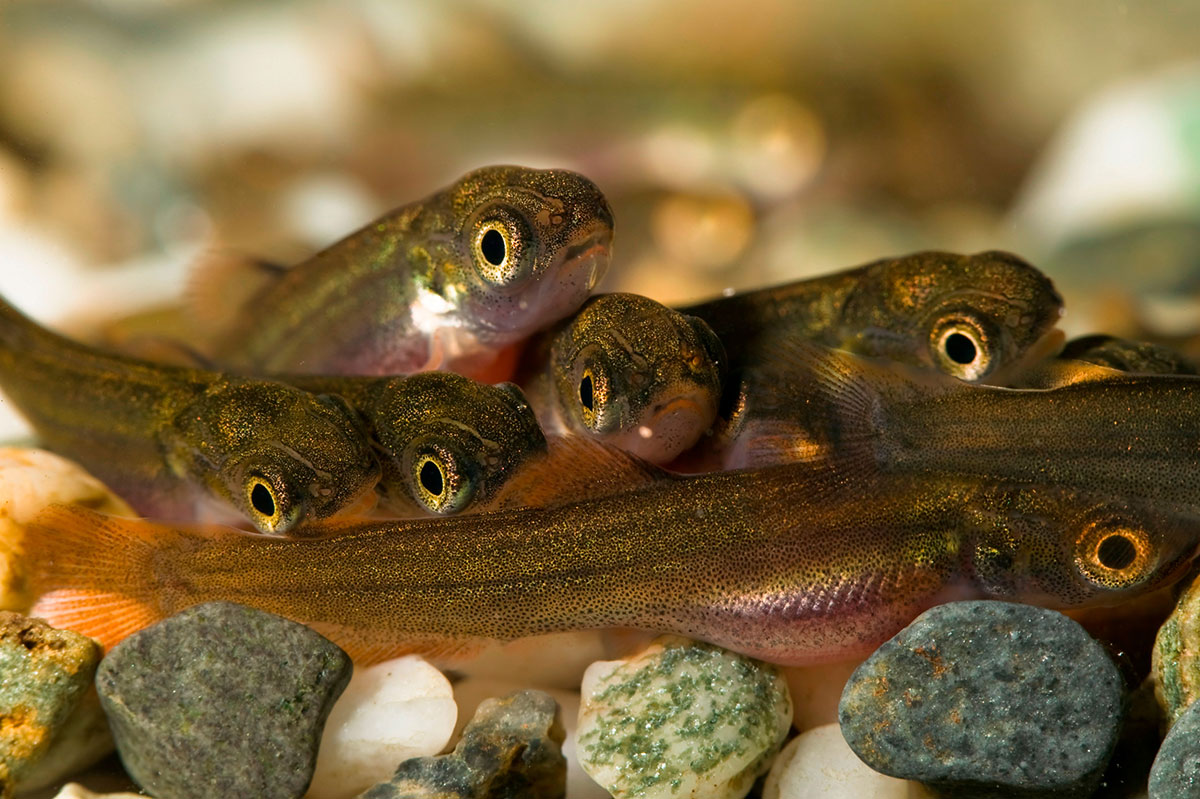
Enrichment was helpful, but, statistically, the cumbersome evergreens and camouflage paint were not going to guarantee survival for the Upper Yakima River Chinook. Cle Elum and other conservation hatcheries kept the shading and underwater feeding, and delved even more deeply into fish genes. Each step in raising salmon in captivity can have genetic side effects, beginning with collection of fish from the wild as broodstock. Gather too few and you risk curbing genetic diversity in your hatchery fish. Take too many and you risk depleting the wild population — past research has shown that hatchery-born salmon that reproduce in the wild tend to produce fewer offspring and are more likely to die before spawning.
Once in captivity, salmon adapt quickly. In a study published in 2016, Mark Christie, an evolutionary biologist at Purdue University in Indiana, and co-authors reported that just one generation in a hatchery led to changes in the expression of hundreds of genes in steelhead trout, a species that, like most salmon, moves between fresh and salt water across its life cycle. The authors suggested that in hatchery tanks crowded with aggressive compatriots, the trout could be dialing up the activity of genes known to help fish heal wounds quickly and resist disease; over time, domestication can — in the parlance of geneticists — “select” for these and other traits. Such genetic changes provide advantages in the hatchery but might hinder salmon after release. “It’s difficult to optimize fitness in both environments,” says Christie. “They are adapting to this captive environment, and that often results in a trade-off with fitness in the wild.”
Even when a salmon run is limping along, starting a hatchery is likely to have a negative effect, says Robin Waples, a senior scientist with NOAA Fisheries who has studied the genetic risks of hatchery production for nearly three decades. But the worse things get, the more likely that a hatchery will help. When a wild population is on the brink of disappearing, it may be the most realistic immediate option. “You could accept quite a bit of risk from a hatchery operation because even domestication selection in a hatchery isn’t as bad as extinction,” Waples says.
Unfortunately, that’s precisely the situation salmon conservationists face in more and more waterways. In the Russian River, the decision to take the last wild-born coho into captivity came almost too late.
Government biologists began scouring the Russian River watershed to capture young fish in 2001. Within two years, they were finding coho in only two tributaries. In 2004, they found none.
In fact, the captive breeding program started with so few coho — just a few hundred young from each year’s cohort — that their descendants, bred by Warm Springs staff, were too closely related. Genetic mutations emerged, such as fish born with twisted spines. “Pretty much all animals have developed ways to identify close relatives and avoid mating with them,” says John Carlos Garza, a NOAA geneticist who works with conservation hatcheries in California. In captivity, people interfere with mate choice by deciding which salmon to spawn together. The act is anything but romantic: a technician kills the fish with a bonk to the head, squeezes the female’s eggs into plastic dishes or a pail, then adds a squirt of milt from one or more males.
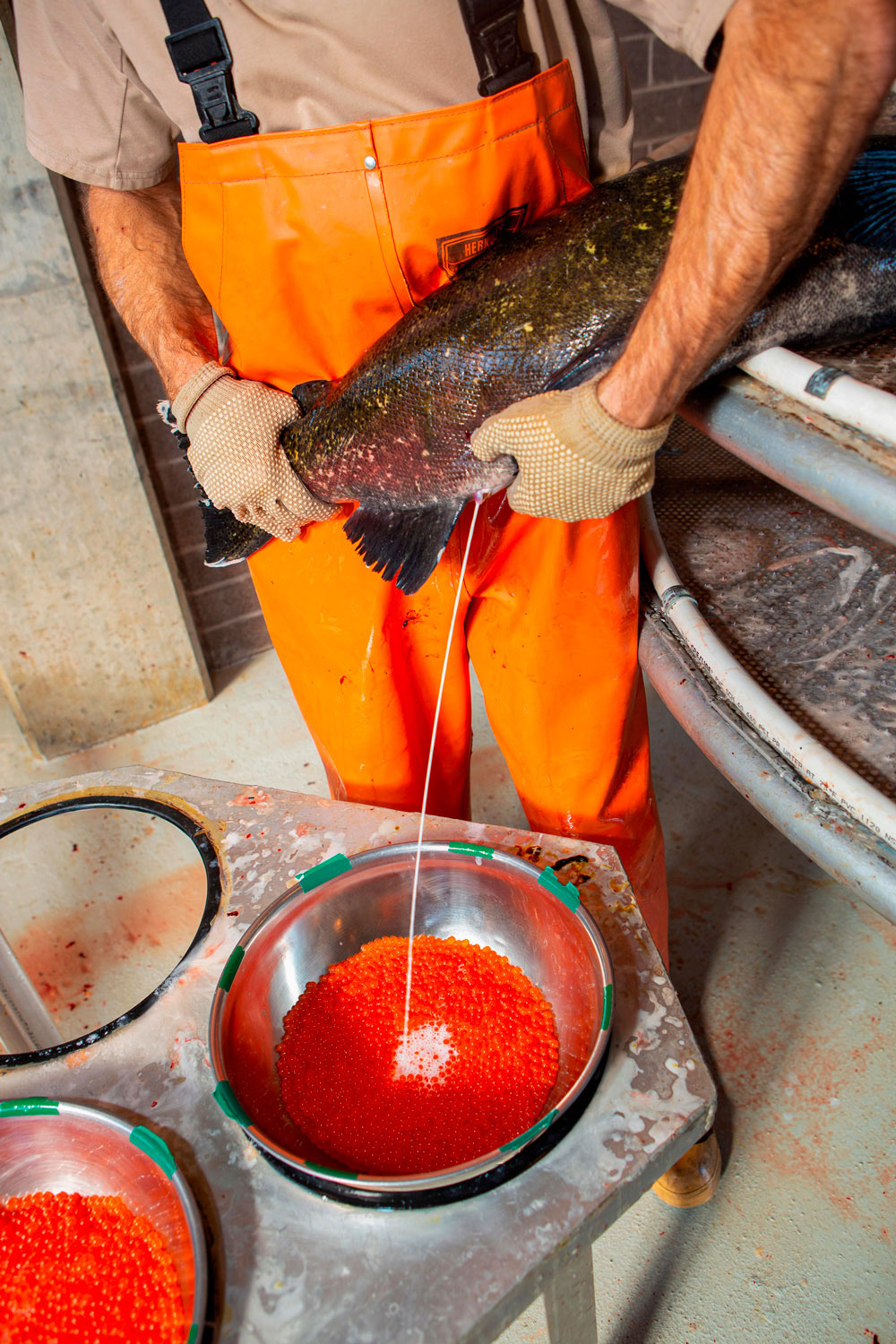
To avoid inbreeding between close relatives, zoos that raise endangered animals keep pedigreed stud books, like family trees for rhinos or elephants. Garza’s idea was to use genetic markers — known landmarks within the DNA code — to identify distantly related coho that could safely reproduce with one another. Every spawning season since 2001, Warm Springs staff have FedExed slivers of fin tissue from adult coho overnight to Garza’s lab at the University of California’s Santa Cruz campus. Within days, Ben White, who manages the Warm Springs coho captive breeding program, receives a matchmaking list that pairs females with the most distantly related males. Each female is spawned with the four available males that rank highest on the list.
Not all of those males have roots in the watershed. Early on, Garza urged the California Department of Fish and Wildlife to allow what scientists call “genetic rescue.” He wanted to bring in wild coho from a nearby creek outside the Russian River to diversify the gene pool. “We got a huge amount of pushback,” recalls Garza. “‘You can’t do that. You can’t make Frankenstein fish.’” The opposition came from stakeholders in multiple agencies and NGOs who feared that breeding fish from separate watersheds could produce offspring that weren’t genetically fit for either river. Garza countered that even under natural conditions, a small percentage of salmon stray, spawning in different rivers than where they were born. It took five years to convince everyone involved and secure the Department of Fish and Wildlife permit. Almost immediately after adding the new coho to the mix in 2008, White saw fewer fish with deformities and higher rates of survival. Each winter, Warm Springs staff fertilize up to half a million eggs. Before the influx of new genes, fewer than 100,000 grew into young fish that could be released into the watershed. Since then, that number has more than doubled, though less than one per cent of these fish live long enough in the wild to return to the watershed as adults.
The coho building at the Warm Springs hatchery is open and breezy, resembling a small airplane hangar brightened by skylights. The air is sweetly fishy. White, a fisheries biologist with the US Army Corps of Engineers, shows me around the complex, which was constructed and is still operated by the corps as mitigation for damming Lake Sonoma. An energetic man in a ball cap with a dark, neatly trimmed beard, White speaks loudly over the water rushing through drains under the cement floor. Two rows of shallow troughs house young coho destined for release. At the far end of the room, a dozen round tanks, like green above-ground swimming pools, hold up to 1,500 adults that White keeps on site to spawn the next generation. The rest of the roughly 200,000 coho that Warm Springs now produces annually are loaded into blue water jugs fitted with backpack straps and aerators. Hatchery staff, occasionally joined by local landowners and schoolkids, heft the packs and hike to streams around the watershed to set the fish free in the best habitat they can find. After raising these small fish so carefully, White and his team must finally leave the coho to fend for themselves, with odds of survival agonizingly slim.
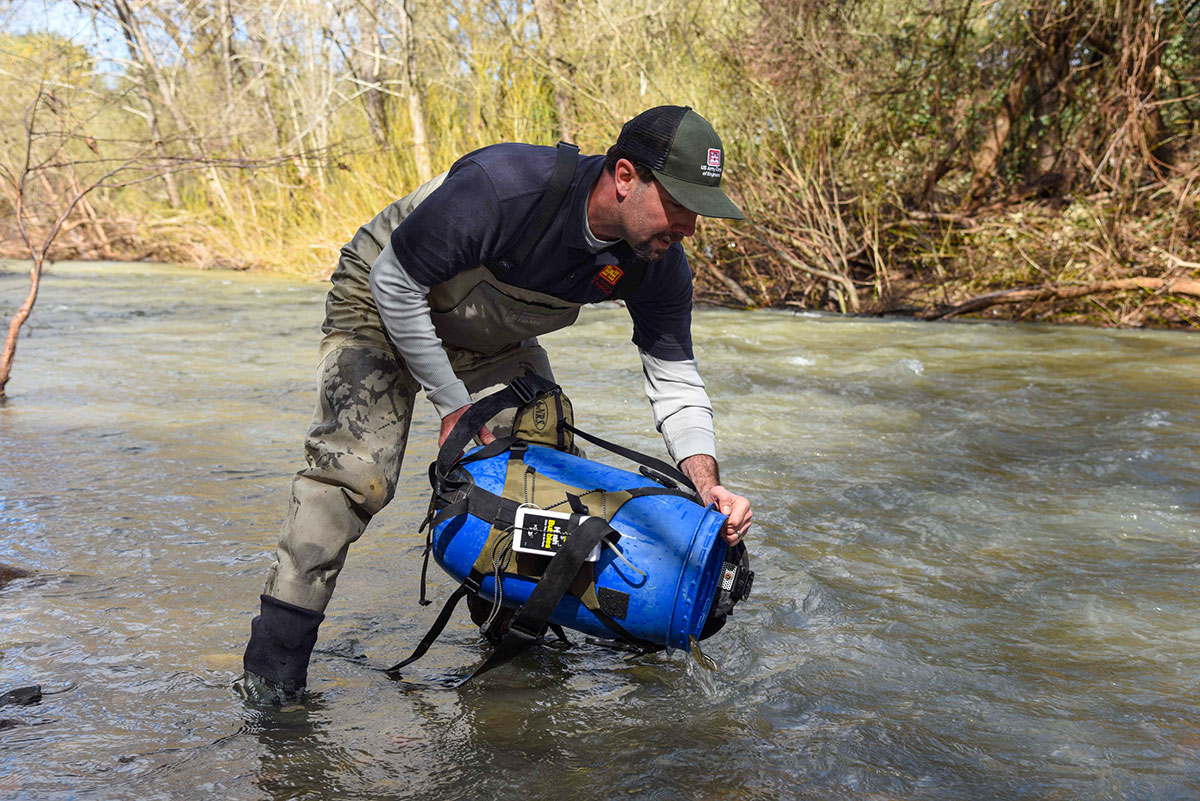
When the recovery program started, Warm Springs discharged coho at a very young age to minimize adaptation to the hatchery. “Our goal was to get them out as early as possible,” says White, but few were surviving in the wild. “If you’re losing all your fish, it’s like, what’s the point?” he says. In a wild population of salmon, high mortality rates for young fish — of up to 99 per cent — leave behind the individuals best adapted to thrive in their environments. In conservation hatcheries, though, the main goal is not survival of the fittest, but of every precious fish. White has learned to spread the risk by releasing coho at almost every life stage, from eggs that hatch out of in-stream incubators, to 16-month-old fish heading for the Pacific, to adults ready to spawn.
With salmon numbers plummeting on the west coast, conservation hatcheries are increasingly proposed to prevent populations from disappearing completely. In 2021, both the U.S. Congress and Fisheries and Oceans Canada announced new investments in hatchery programs. (Both also earmarked funds for habitat restoration and the latter for downsizing fisheries.) Yet more than two decades into the evolution of conservation hatcheries, the work of producing a wildish hatchery fish is going slowly. Subtle but crucial differences remain. Whereas wild-born salmon are cautious and secretive, and will bolt for cover, hatchery fish sometimes approach people expecting food — a behaviour that makes them easy prey.
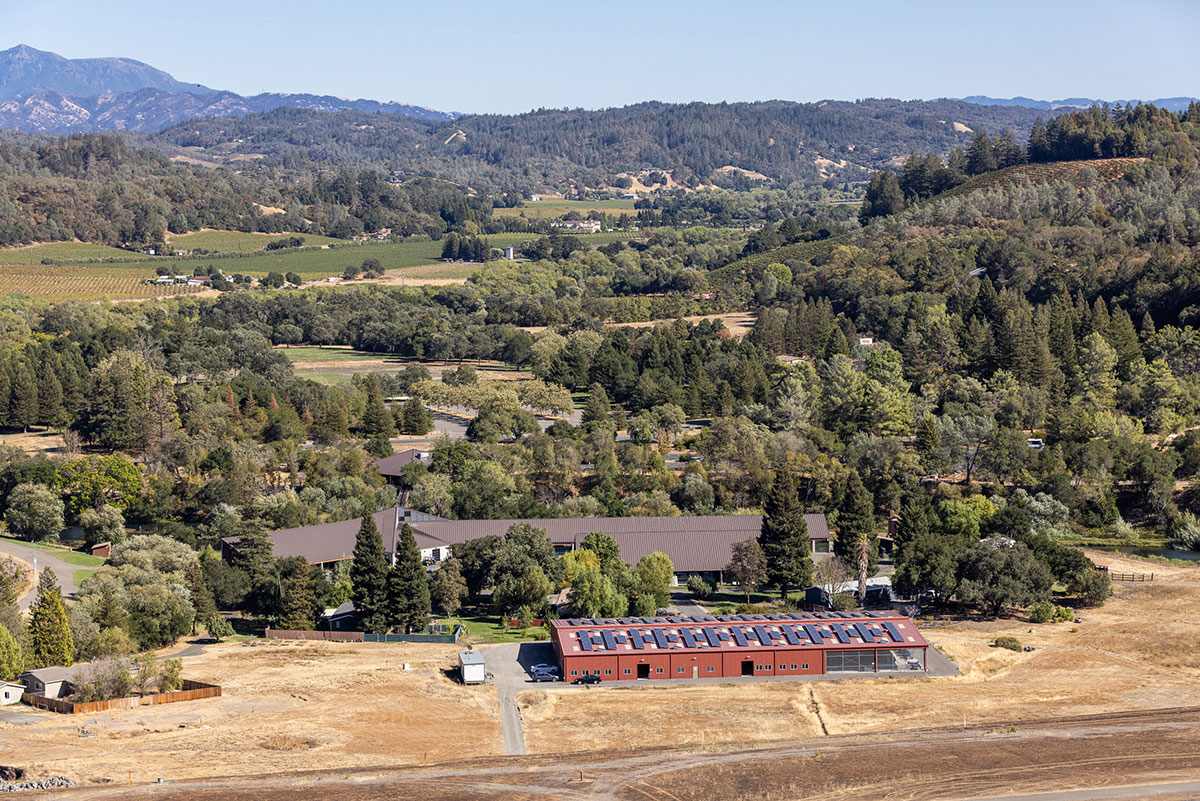
In the Russian River watershed, multiple agencies and non-profits are restoring habitat, but the pace has been too slow to reverse coho declines. Captivity remains the only bulwark against extinction. Thanks to genetic rescue, the recovery program now has the luxury of considering how their coho compare to wild fish. At Warm Springs, the signs of sustained inbreeding have largely disappeared, though on my visit, White points out the pale flash of an albino fish in one trough. Garza and White do their best to take the edge off the hatchery effects, but it’s still an all-hands-on-deck effort just to get more salmon in the river. In some years, the results are more promising, with estimates of up to 800 free-swimming coho descended from hatchery stock returning to the watershed to spawn.
But outside the walls of Warm Springs, so much is beyond the recovery team’s control. By nature, salmon transcend borders and boundaries, which exposes them to a gauntlet of threats. In rivers, fish face warmer water, droughts, wildfires, landslides, predators and pollution; at sea, more predators, fishing and competition for food. By amplifying these hazards, climate change places ever-greater demands on the fish, and their keepers, to adapt. For the program to succeed, many things must go right.
“We’ve never really had big years of returns, but we’ve also never really had everything line up, like ocean conditions, water, our production here,” says White. “It’s always something.”
Even before the summer of 2020, the people working to bring back Russian River coho had known a lot of climate chaos. The series of major wildfires they’ve endured in the last five years are blurring together in memory. Most of the Sea Grant staff have been evacuated from the area at least once. Obedzinski has had a fire burn within 50 metres of her house and once authored a project report from temporary accommodations with family. Late one night in 2019, as the Kincade Fire approached the town of Windsor, where the Sea Grant program is based, Ruiz took an Uber to the office to back up crucial data in case the building burned down. Two years earlier, another team member lost his family home. From the end of June until November, everyone is on edge.
In mid-August 2020, temperatures spiked to almost 40 C. Nearly 90 days had passed without significant rain, and the Sea Grant office was getting frequent notices from the electrical company, warning of potential outages to prevent fires sparked by wind damage to power lines. On Aug. 17, dry lightning ignited the Walbridge Fire, which spread southeast into the Mill Creek valley, northeast toward Lake Sonoma and Warm Springs, and south into protected forests. Within two days, 10,000 people were ordered to evacuate. On the edge of the evacuation zone, the hatchery moved to a skeleton crew, doing the essential work to keep the coho alive.
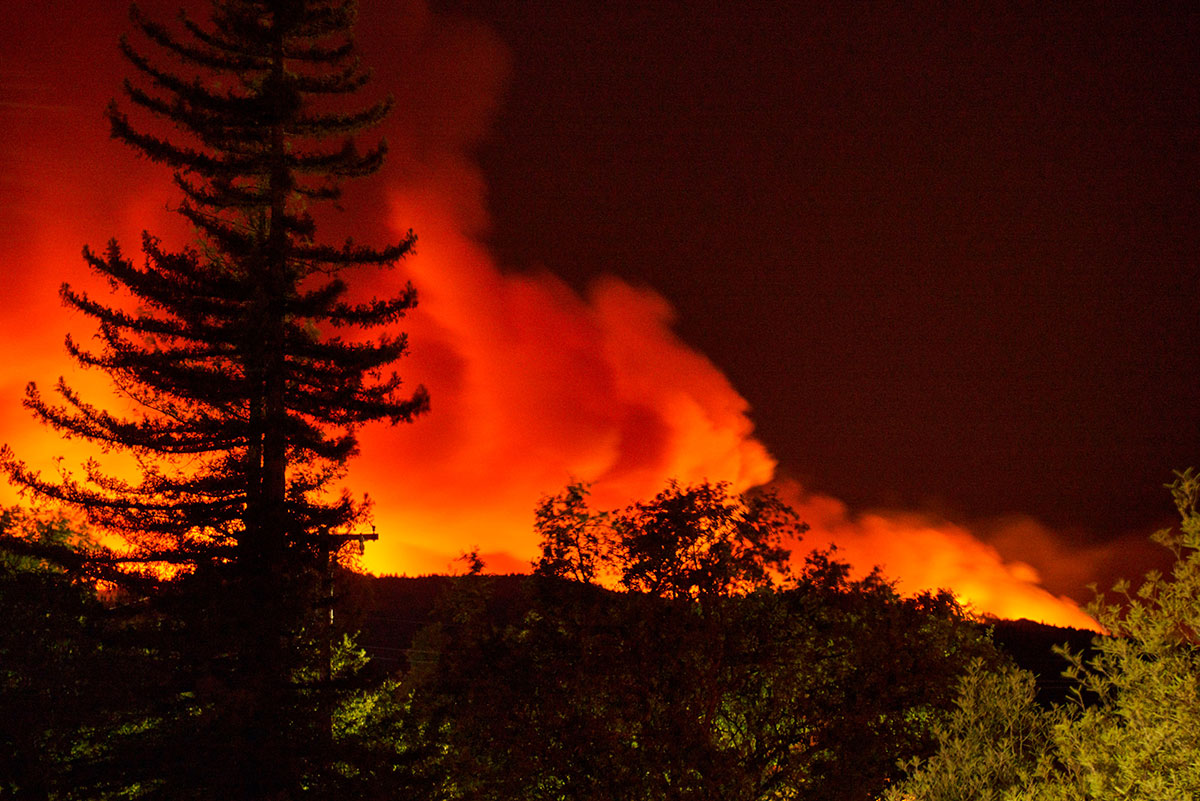
“It was a big eye-opener,” says White. Power to the area was out and the diesel supply tank was malfunctioning, so someone had to refuel one of the hatchery’s backup generators every six to eight hours or the water pumps would stall. “We want those generators to be able to run for days at a time, so if somebody can’t be here, at least we know the fish have water,” he says. By mid-September, the Walbridge Fire had burned an area the size of Seattle and destroyed 293 structures, including the homes of landowners who help with coho recovery.
The fire was finally contained in early October, but California’s drought continued. The salmon were still in danger. Earlier in the year, the Sea Grant team had counted record numbers of wild-born coho in the watershed; that fall, they returned to pools that had held fish to find some completely dry. Winter rains came late, and very few streams had enough water for adults to spawn. In the spring of 2021, just as 30,000 six-month-old hatchery coho were trying to swim out to the Pacific, drought again stopped many tributaries from flowing. Working overtime, the Sea Grant team helped Fish and Wildlife staff rescue stranded fish.
“The creeks are dry. Dry, dry, dry, dry, dry — like, not even a trickle flowing through them,” Ruiz told me in mid-June 2021, describing juvenile coho pressing their faces into the gaps between rocks to keep their gills wet. Knowing that release into the tributaries could be a death sentence, White stocked some fish into the cool waters of Dry Creek and kept the rest at the hatchery over the summer. “It’s one of the most challenging parts of my job,” he says. “Releasing fish into unreliable water.”
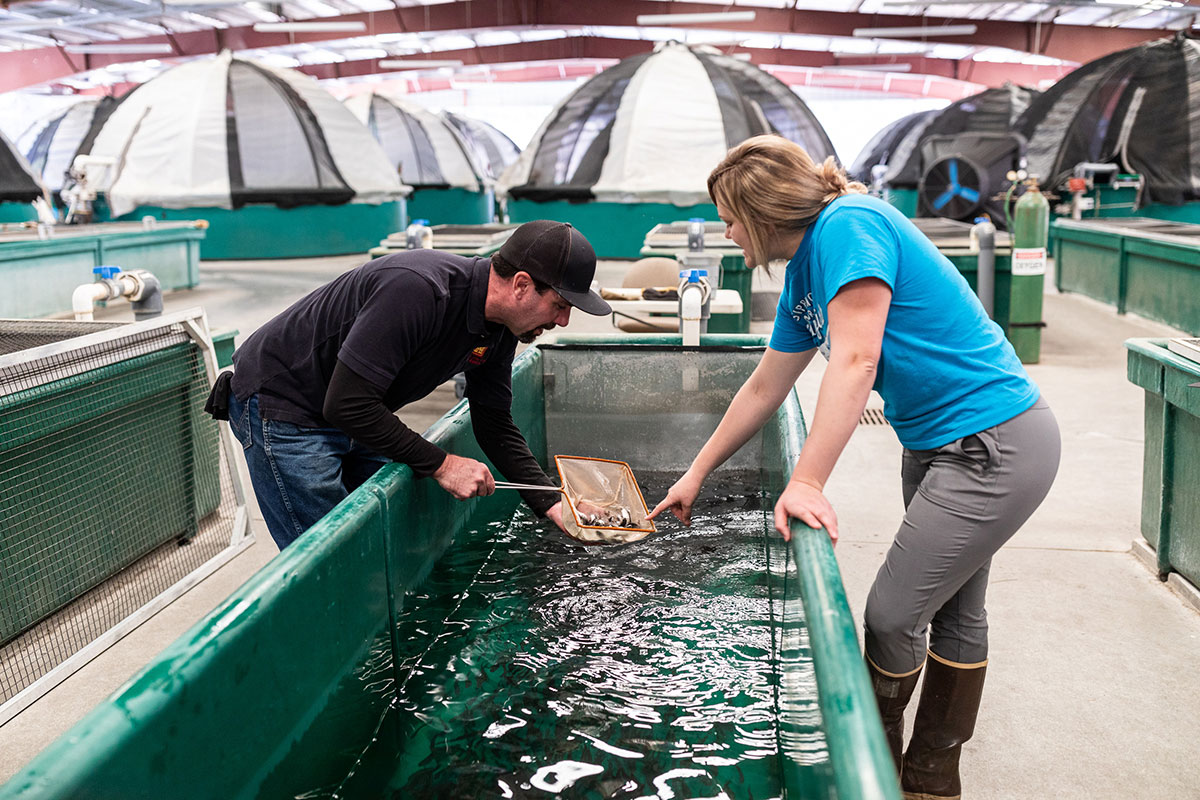
Dry summers aren’t unusual — most years, Sonoma County sees little rain from May until October — but by August 2021, the drought had become a crisis. The Russian River watershed’s two reservoirs, which supply drinking water for around 700,000 people in three counties, were at historic lows. To preserve water for people and the endangered salmon, regulators banned nearly 2,000 farmers, ranchers and winegrowers from diverting water for irrigation and livestock. Conditions were the worst that White has seen in two decades. “Right now, essentially all of the creeks in the watershed are unsuitable for salmon survival,” he said by email in mid-August. In the hatchery, the situation had also become precarious. With Lake Sonoma only half full, the dam’s intakes were drawing water that was 3 to 6 C too warm for coho. As young fish began to die, White weighed plans to move them, fearing that conditions at other locations would be no safer.
In the end, the Army Corps gave the go-ahead to open the dam’s maintenance gates to draw deeper, cooler water. Temperatures in the hatchery dropped to a favourable 11 C. As insurance, Warm Springs staff trucked 4,000 young coho 70 kilometres to a small facility in Petaluma, California, with a groundwater well.
Coming a year after Warm Springs was nearly evacuated for the Walbridge Fire, the relocation was another signal that even the refuges we build to protect fish are vulnerable in an era of rapid environmental change. The hits just keep coming in the Russian River and the message is clear: the most cutting-edge conservation hatchery is not enough to save a floundering population. Fish need intact habitat. We can’t have salmon without rivers.
It’s a sunny day in late September 2021, a year after the Walbridge Fire, and Ruiz and fellow Sea Grant fisheries biologist Zac Reinstein are driving up the narrow, winding road into the Mill Creek valley to survey salmon habitat once again. Signs of fire, and recovery from it, are everywhere: charred redwoods covered in a green fuzz of new growth, saws buzzing as disaster response crews clear damaged trees and landowners rebuild homes. “This looks different every time I come here,” says Ruiz, pulling on waders.
Farther downstream, where Mill Creek meets Dry Creek, the channel is so dry that stepping onto the desiccated streambed sounds like biting into a cracker. Up here in the burn scar, the death of so many thirsty trees has freed up water, leaving the creek fuller than in other drought years. In many places, however, the water barely covers our boots. Ruiz meticulously notes on a tablet where the creek is flowing and where it is dry, while Reinstein, a chatty, lanky, fly-fishing enthusiast, drops a cigar-shaped sensor into the pools to check if the water is cool and oxygenated enough for coho.
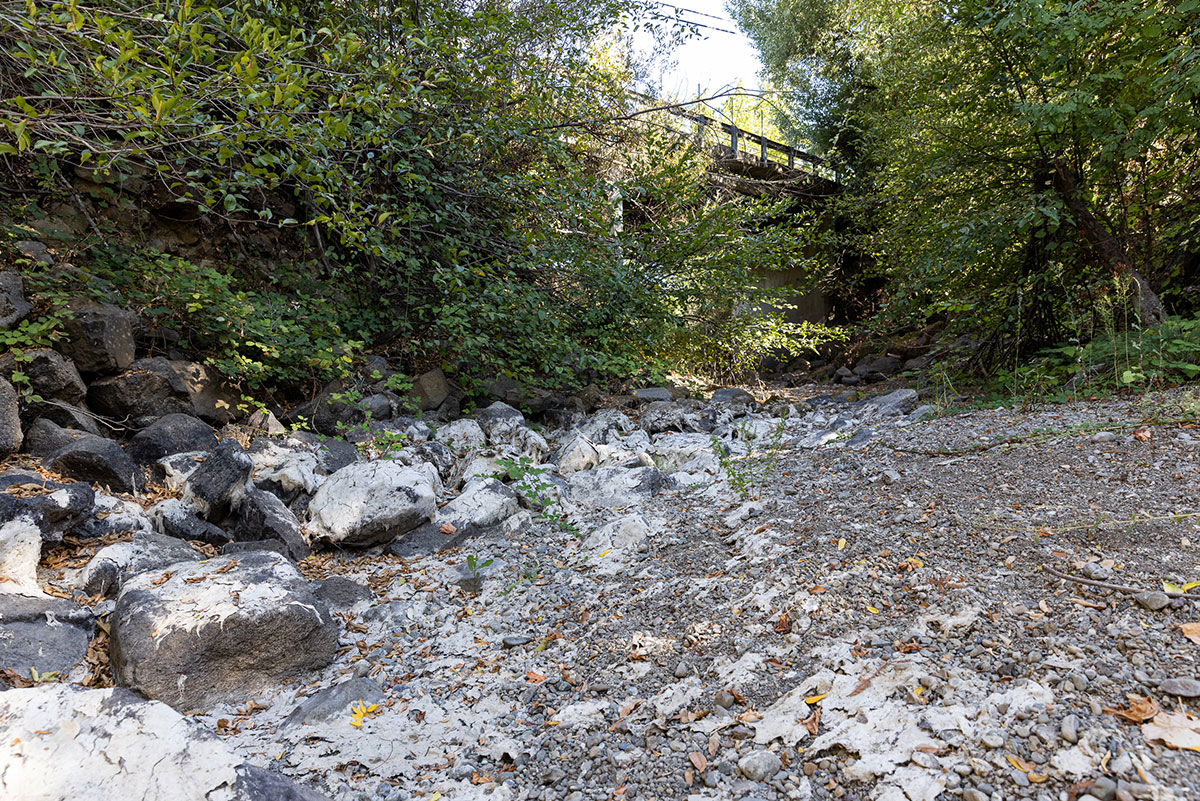
The creek is hospitable at first, but in one pool the oxygen dips low enough to be stressful for coho. Ruiz records the value to publish on the Sea Grant website. For now, there’s no remedy for the fish; the team’s job is to record stream conditions, not to intervene. “Running miles and miles of aerators — that’s definitely been talked about,” Reinstein says, though the idea has never been seriously considered. Along a shallow stretch upstream, the pair finds two unopened water bottles discarded on the bank. Reinstein picks one up. “We should do a flow augmentation,” he jokes, miming emptying the bottle into the creek.
At one bend, a warm, ambrosial breeze blows off a cleared slope. Ruiz stares up at the hilltop, distorted by waves of hot air that hint at a warmer creek in years to come. “I’m thinking about how long it’s going to take for the system to recover from all of this disturbance, and what that’s going to mean for the fish in the short term,” Ruiz says, their voice tight with emotion. The waterway is now littered with new logs, some toppled by the blaze, some felled since. The logs offer young coho shade and shelter from predators, but as the roots of fatally burned trees slowly die on the slopes above, they will no longer hold back the winter rains from washing topsoil into the creek and burying salmon eggs. “It’s typically the second and third winter after a fire that you start seeing those big slides,” Reinstein says.
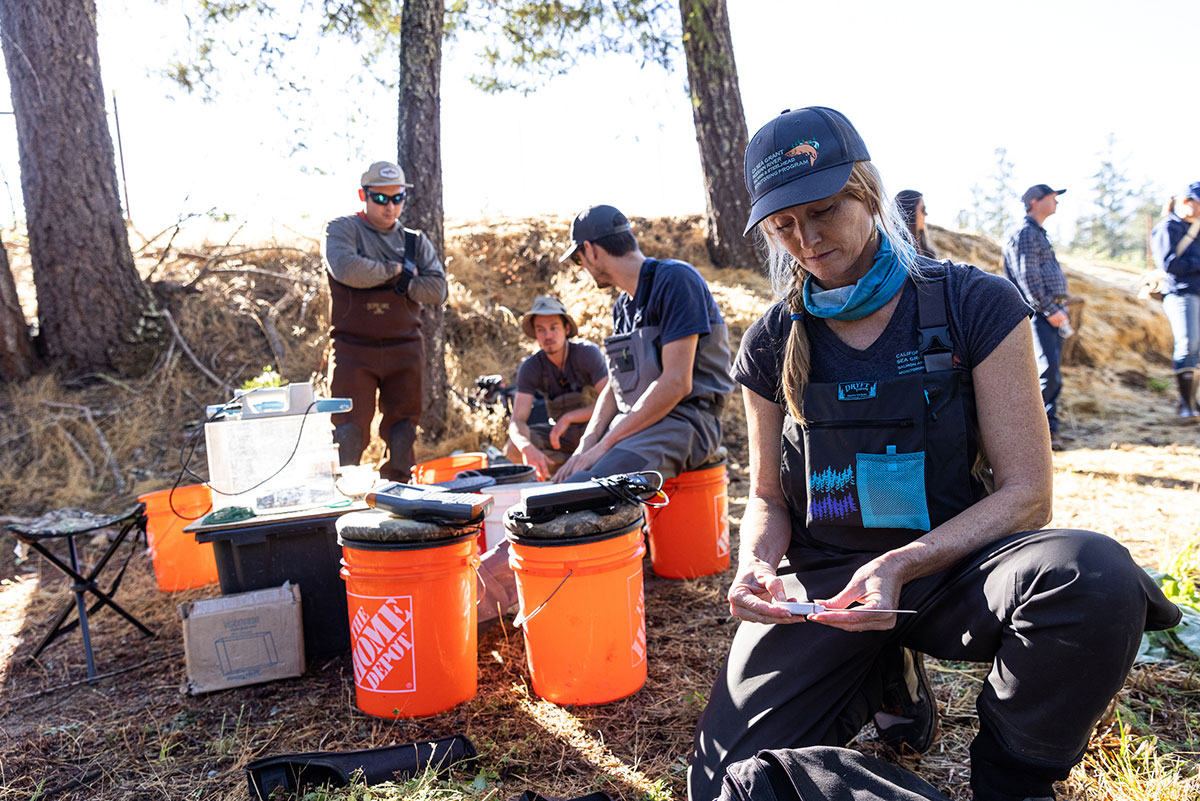
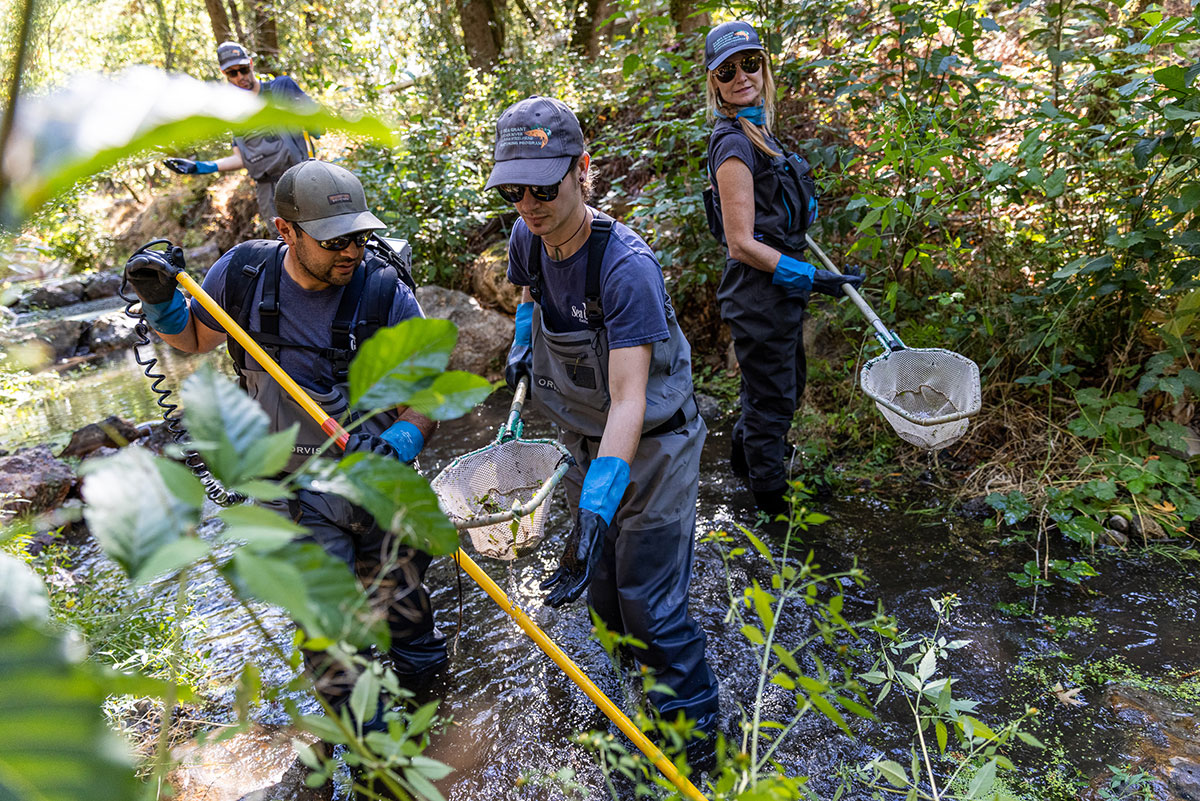
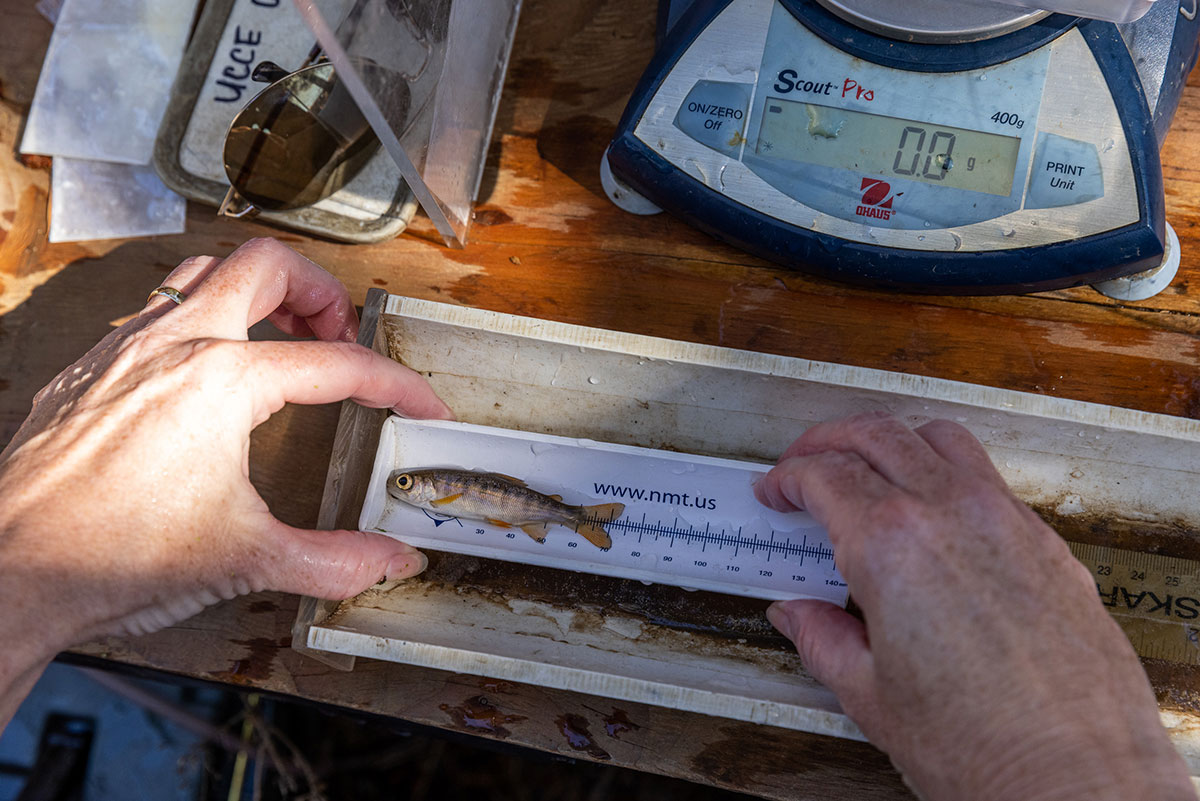
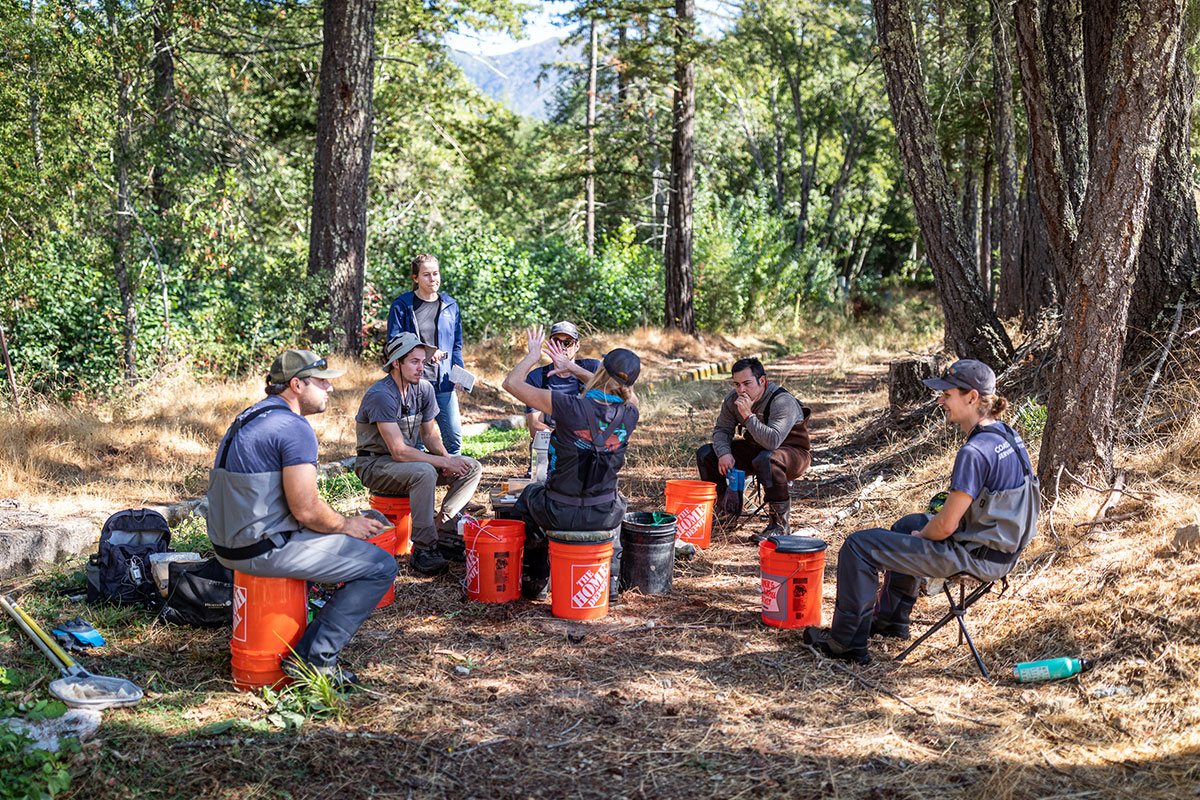
Less than a month after Ruiz and Reinstein’s walk through the recovering forest, rain does finally come. Like most weather in Sonoma these days, it does not come in a normal way. After one of the county’s driest years on record, two weather systems converge on the California coast in the most powerful storm in more than a generation. The “bomb cyclone” and “atmospheric river” pound the region with rain, flooding neighborhoods and taking the Russian River watershed’s streams from dry to overflowing within a day. When the storm passes, leaving the tributaries full, White begins releasing the coho he managed to keep alive through the summer. Adults start moving upstream, and by January 2022, Sea Grant biologists have tallied the most spawning fish since counts began in 2013. Coho are spotted in nearby rivers for the first time in 25 years. But the winter rains don’t last. Two months later, riverbeds containing freshly laid coho eggs are already beginning to dry and White, Obedzinski and Ruiz are bracing for another year of extreme drought.
In years like the past two, everyone wonders how far the recovery team will need to go to ensure that the Russian River once again has a free-running population of coho. Already, the aquaculture industry is searching for ways to breed heat-tolerant salmon to grow in warming waters around the world. But selecting for a single trait is complicated. Genes interact with each other in enigmatic ways, producing unexpected results. When animal breeders try to high-grade a desirable characteristic, other genes can get dragged along, raising the possibility of accidentally magnifying a deleterious trait. Genetic engineering techniques that allow scientists to “edit” an organism’s DNA, for example by inserting a gene that promotes heat tolerance, aren’t currently used as a conservation strategy for salmon. Whether conservation hatcheries adopt genetic engineering depends, in part, on how dire things become. If a pandemic threatened to wipe out all coho salmon, for instance, scientists might be desperate enough to search for, and consider inserting, a gene that confers immunity.
If the choice for an increasing number of rivers is hatchery salmon or no salmon at all, the situation in the Russian River now represents a further fork in the road. Do we commit to evermore human intervention to keep even hatchery fish alive, or somehow summon the political will to replant native forests, stop impeding rivers and return watersheds to a more natural state so salmon can get back to sustaining themselves?
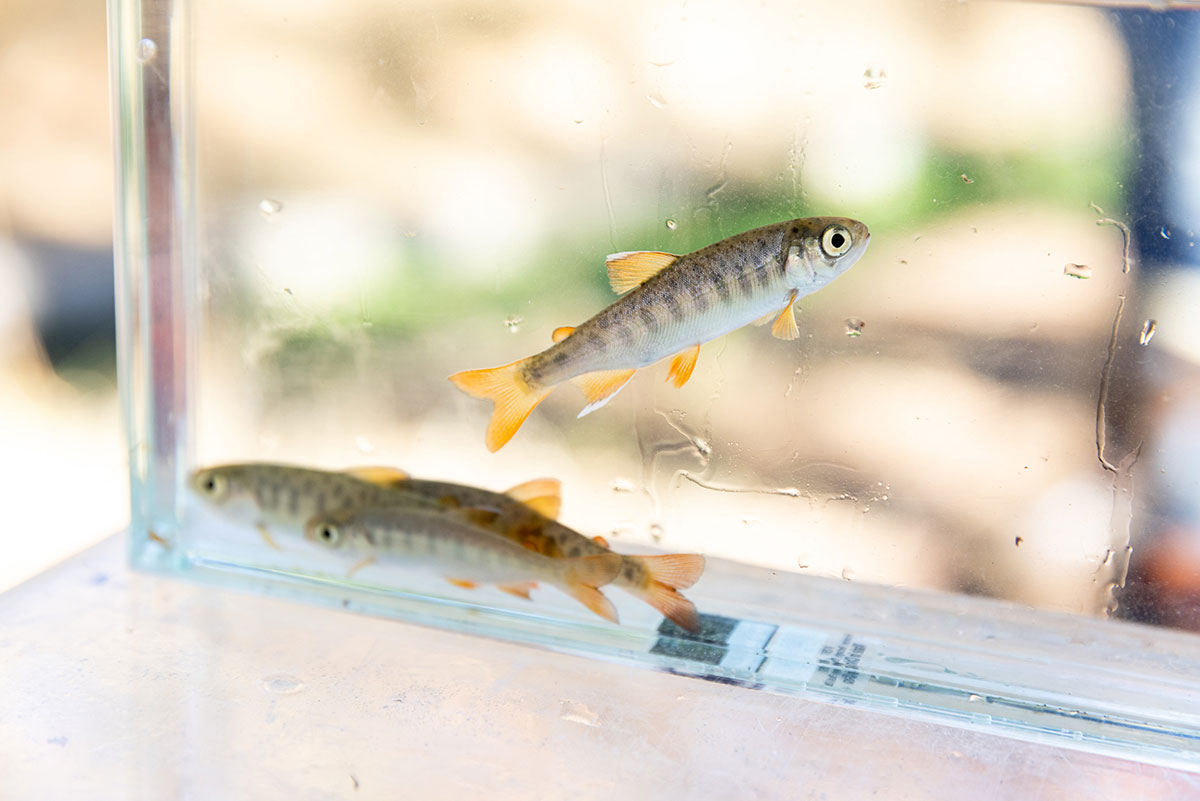
Neither course will be easy. “There’s no track record of us being able to do hatchery supplementation indefinitely,” says Waples, the NOAA fisheries scientist. He cites numerous ways that a hatchery stock can fail, from epidemic disease and natural disasters to the most mundane of human errors — someone forgetting to replace a drain plug. He doubts our collective ability to keep these balls in the air for the decades or centuries it may take to restore salmon habitat and slow climate change.
Sea Grant’s Obedzinski still believes that the Russian River can be saved. She sees progress in the recent collaboration among landowners to increase the water available for fish, but also knows much more needs to be done. “We need to conserve water on a watershed scale,” she says.
Whether efforts to sustain these rare coho succeed or fail, Obedzinski says, the program stands as a case study for watersheds farther north that will see similarly extreme climate change in decades to come. “We’ve learned a tremendous amount,” she says. She encourages other recovery efforts to study the team’s work in the Russian River before making the enormous investment in a conservation hatchery.
Even if all goes extremely well from now on, Russian River coho aren’t expected to reach even half their historical abundance in our lifetimes. The recovery plan, developed by NOAA a decade ago, predicts that the run won’t reach its target of 10,100 annual spawners until 2120. With such a long timeline, anything could happen. Predictions depend on what persuasion — optimist, pessimist, pragmatist — you bring to the following question: What the hell will central California look like in 100 years?
Read the first feature in this series, ‘The Hatchery Crutch,’ and the second feature, ‘Can We Have Too Much Pink Salmon?’ Tomorrow: Tribal Hatcheries and the Road to Restoration. ![]()
Read more: Science + Tech, Environment


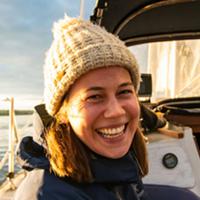
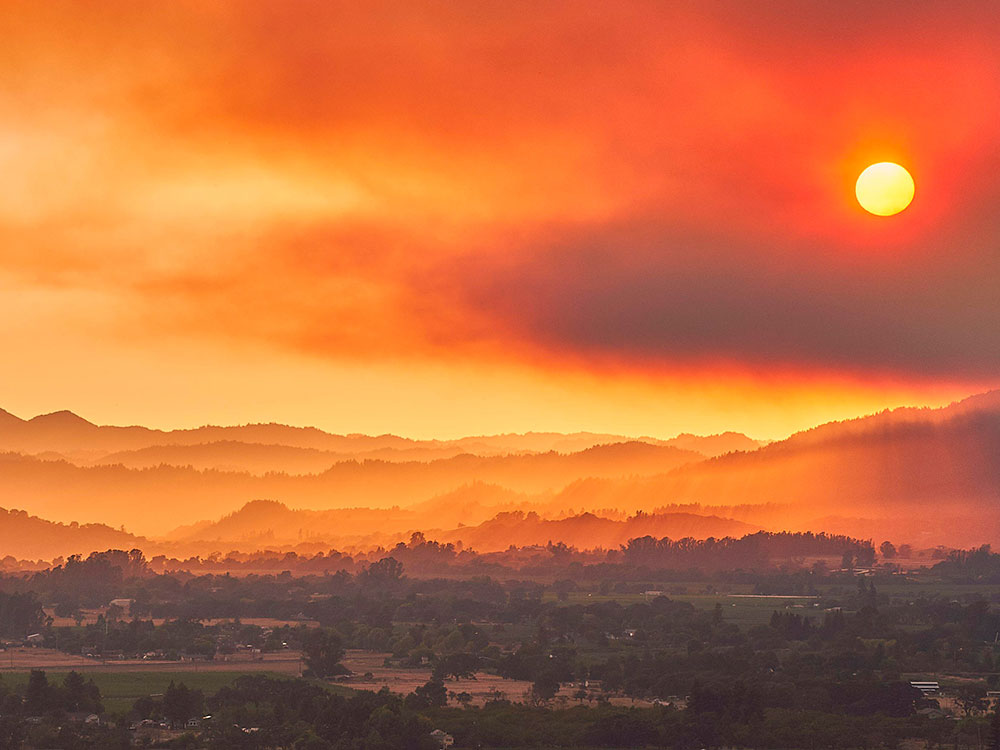












Tyee Commenting Guidelines
Comments that violate guidelines risk being deleted, and violations may result in a temporary or permanent user ban. Maintain the spirit of good conversation to stay in the discussion.
*Please note The Tyee is not a forum for spreading misinformation about COVID-19, denying its existence or minimizing its risk to public health.
Do:
Do not: